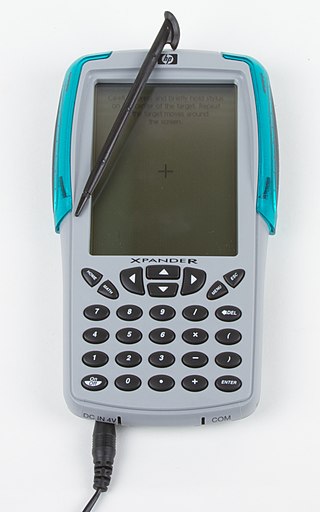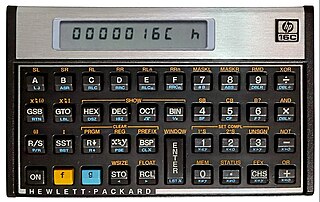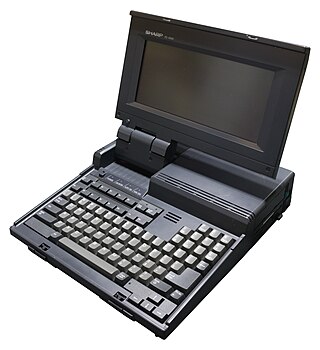
An electronic calculator is typically a portable electronic device used to perform calculations, ranging from basic arithmetic to complex mathematics.

A Pocket PC is a class of personal digital assistant (PDA) that runs the Windows Mobile or Windows Embedded Compact operating system that has some of the abilities of modern desktop PCs. The name was introduced by Microsoft in 2000 as a rebranding of the Palm-size PC category. Some of these devices also had integrated phone and data capabilities, which were called Pocket PC Phone Edition. Windows "Smartphone" is another Windows CE based platform for non-touch flip phones or dumber phones.

A scientific calculator is an electronic calculator, either desktop or handheld, designed to perform calculations using basic and complex mathematical operations and functions. They have completely replaced slide rules as well as books of mathematical tables and are used in both educational and professional settings.
4-bit computing is the use of computer architectures in which integers and other data units are 4 bits wide. 4-bit central processing unit (CPU) and arithmetic logic unit (ALU) architectures are those that are based on registers or data buses of that size. A group of four bits is also called a nibble and has 24 = 16 possible values.

A mobile device or handheld computer is a computer small enough to hold and operate in the hand. Mobile devices are typically battery-powered and possess a flat-panel display and one or more built-in input devices, such as a touchscreen or keypad. Modern mobile devices often place emphasis on wireless networking, to both the Internet and to other devices in their vicinity, such as headsets or in-car entertainment systems, via Wi-Fi, Bluetooth, cellular networks, or near-field communication.

The HP-20S (F1890A) is an algebraic programmable scientific calculator produced by Hewlett-Packard from 1987 to 2000.

The Sharp PC-1211 is the first pocket computer ever released, marketed by Sharp Corporation in March 1980. The computer was powered by two 4-bit CPUs laid out in power-saving CMOS circuitry. One acted as the main CPU, the other dealt with the input/output and display interface. Users could write computer programs in BASIC.

The Tandy Pocket Computer or TRS-80 Pocket Computer is a line of pocket computers sold by Tandy Corporation under the Tandy or Radio Shack TRS-80 brands.

A handheld personal computer (PC), typically built around either a clamshell form factor or a gaming form factor with a gamepad integrated for video games, is a mobile device that is significantly smaller than any standard personal computer (PC), but based on the same principles as PCs. The clamshell form factor is sometimes referred to as a palmtop computer, not to be confused with Palmtop PC which was a name used mainly by Hewlett-Packard.

The LTE is a line of notebook-sized laptops manufactured by Compaq Computer Corporation, introduced in 1989 and discontinued in 1997. It was the first notebook computer sold by Compaq and the first commercially successful notebook that was compatible with the IBM PC.
Programmable calculators are calculators that can automatically carry out a sequence of operations under control of a stored program. Most are Turing complete, and, as such, are theoretically general-purpose computers. However, their user interfaces and programming environments are specifically tailored to make performing small-scale numerical computations convenient, rather than general-purpose use.

The Jornada was a line of personal digital assistants or PDAs manufactured by Hewlett-Packard. The Jornada was a broad product line that included Palm-Size PCs, Handheld PCs, and Pocket PCs. The first model was the 820, released in 1998, and the last was the 928 model in 2002 when Compaq and HP merged. The Jornada line was then succeeded by the more popular iPAQ model PDAs. All Jornada models ran Microsoft Operating Systems that were based on Windows CE.

The HP Xpander (F1903A) aka "Endeavour" was to be Hewlett-Packard's newest graphing calculator in 2002, but the project was cancelled in November 2001 months before it was scheduled to go into production. It had both a keyboard and a pen-based interface, measured 162.6 mm by 88.9 mm by 22.9 mm, with a large grayscale screen, and ran on two rechargeable AA batteries. It had a semi-translucent green cover on a gray case and an expansion slot.

The HP-16C Computer Scientist is a programmable pocket calculator that was produced by Hewlett-Packard between 1982 and 1989. It was specifically designed for use by computer programmers, to assist in debugging. It is a member of the HP Voyager series of programmable calculators. It was the only programmer's calculator ever produced by HP, though many later HP calculators have incorporated most of the 16C's functions.

The HP 95LX Palmtop PC, also known as project Jaguar, is Hewlett Packard's first DOS-based pocket computer, or personal digital assistant, introduced in April 1991 in collaboration with Lotus Development Corporation. The abbreviation "LX" stood for "Lotus Expandable". The computer can be seen as successor to a series of larger portable PCs like the HP 110 and HP 110 Plus.
The Compaq Professional Workstation was a family of workstations produced by Compaq. Introduced in late October 1996, the first entry in the family featured single or dual Pentium Pro processors. Later entries featured Pentium IIs and IIIs; the XP1000 was the only non-x86 based entry, featuring a DEC Alpha processor. Compaq aimed the Professional Workstation at computer-aided design users, software programmers, multimedia designers and financial workers. While workers of those fields primarily ran Unix-based operating systems on workstations at the time, the Compaq Professional Workstation came preinstalled with Windows NT 4.0 Workstation. The line was discontinued in 2002.

The Sharp PC-4500 is a line of laptop computers released by Sharp Corporation in 1987. The line comprises the PC-4501, the PC-4502, and the PC-4521. The PC-4501 is a bare-bones unit with only 256 KB of RAM stock, only one floppy drive, no backlighting, and no built-in numeric keypad; the PC-4502 and PC-4521 bumps the stock RAM to 640 KB and includes the latter two features while providing either two floppy drive (PC-4502) or one floppy drive and a 20 MB hard drive (PC-4521). Prices on the line initially ranged from $1,295 to just under $3,000; the PC-4501 was later sold for $995, becoming one of the first sub-$1,000 laptops available on the market. The PC-4500 line received mixed, mostly positive, reviews on its release in September 1987.

The SupersPort is a line of PC-compatible laptops manufactured by Zenith Data Systems and sold from 1988 to 1993. The first two main entries in the SupersPort line included either an Intel 80286 microprocessor clocked at 12 MHz or an 8088 processor clocked at 8 or 4.77 MHz, switchable. Later entries included the 386SX, 486SX and 486 processors. The SupersPort 286 in particular was one of the top-selling laptops of the late 1980s, although Zenith's position in this segment faltered by the early 1990s.

Aox Inc. was a privately run American technology corporation founded by Michael and Linda Aronson in 1978. Over the course of its 22-year lifespan, the company chiefly developed software and hardware for IBM's PC and compatibles, for the Personal System/2, and for the Macintosh. In its twilight years, the company designed multimedia and teleconferencing devices and chip designs. Aox was founded after Michael Aronson graduated from Harvard University with a doctorate in physics; he stayed with the company until 2000, when he incorporated EndPoints Inc. and switched to full-time fabless semiconductor design.

A notebook computer or notebook was historically a laptop whose length and width approximate that of letter paper.


















